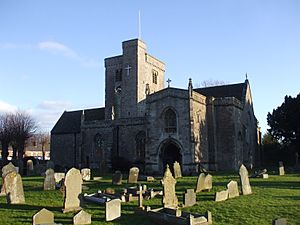St Mary's Church, Magor facts for kids
Quick facts for kids St Mary's, Magor |
|
|---|---|

St Mary's, Magor
|
|
| 51°34′44″N 2°49′51″W / 51.5788°N 2.8307°W | |
| Location | Magor, Monmouthshire |
| Country | Wales |
| Denomination | Church in Wales |
| Architecture | |
| Years built | late 13th century |
| Administration | |
| Diocese | Monmouth |
The Church of St Mary is a historic building in the middle of Magor village in Wales. It's a very important building, recognized as a Grade I listed building since 1963. This means it's considered one of the most important historic buildings in the country. St Mary's is the main church for the Netherwent Ministry Area, which serves a large community. The current leader of this area is Rev Daniel Frett.
Contents
Discover St Mary's Church
This church is a special place with a long and interesting past. It has seen many changes over hundreds of years. Learning about its history helps us understand more about the people who lived in Magor long ago.
A Look at Its Past
The Church of St Mary might have first been named after Cadwaladr. He was a Welsh ruler who lived a very long time ago, dying in 664 AD. Later, the church was dedicated to St Leonard. However, in the mid-1800s, the church was restored and given its current name, St Mary's.
Unique Design and Features
The church is built in a style called "Decorated." This style was popular in the late 1200s and early 1300s. It often features detailed carvings and large windows. St Mary's has a tall tower that is part of the main building. The porch, which is the entrance area, was added later, around the 1300s or 1400s. It has strong supports called buttresses. These buttresses are decorated with "ferocious gargoyles and pinnacles." Gargoyles are carved stone figures, often shaped like monsters, that also act as water spouts. Pinnacles are small, pointed towers.
Inside the Church
Inside St Mary's, you can see beautiful stained glass windows from the 1800s. One of these windows, called The Good Shepherd, was made by a famous company, Kempe & Co, in 1930–31. The churchyard, which is the area around the church, is also a burial place. The Welsh composer Mansel Thomas (1909–1986) is buried there.
Nearby History
Right next to the church, you can find the ruins of The Procurator's House. This house was built in the 1500s. It used to belong to the vicarage of Magor, which means it was likely where the local priest lived. Even though it's now a ruin, it adds to the historical feel of the area around the church.

